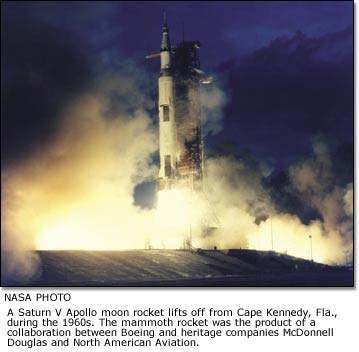| 
BY ERIK
SIMONSEN

 The
1960s represented a period of rapid acceleration of technology, thanks
in large part to two catalysts: the United States sought a strong, multilayered
deterrence to counter the Soviet Union, while President Kennedy in 1961
inspired the nation to go to the moon. The
1960s represented a period of rapid acceleration of technology, thanks
in large part to two catalysts: the United States sought a strong, multilayered
deterrence to counter the Soviet Union, while President Kennedy in 1961
inspired the nation to go to the moon.
On April 12, 1961, the Russians launched cosmonaut Yuri Gagarin into Earth
orbit, initiating an unprecedented American effort not to lose the high
ground. Astronaut Alan Shepard followed this first orbital flight a month
later with a suborbital flight in a McDonnell-built Mercury spacecraft.
On Feb. 20, 1962, John Glenn became the first American to orbit the Earth
in a Mercury spacecraft. Over the next several years, an inspired U.S.
space program proceeded with the McDonnell two-man Gemini, perfecting
techniques that incrementally built up on-orbit experience. This effort
culminated with the North American Aviation (NAA) Apollo spacecraft, featuring
a crew of three. Meanwhile, Boeing, McDonnell Douglas and NAA collaborated
to develop and produce the mammoth 363-foot Saturn V rocket that eventually
propelled Apollo to the moon in 1969.
As the NASA civilian space program pursued its goal of reaching the moon,
the military implemented programs to posture the United States against
the Soviet Union. In the 1960s, Boeing-developed Minuteman intercontinental
ballistic missiles replaced the liquid-fueled Atlas and Titan ICBMs. The
solid-fuel Minuteman missiles were based in underground silos and capable
of launch on short notice.
The decade was also a time for maturation, as jet engines evolved into
more reliable power plants. Fighters could now operate with confidence,
greater thrust-to-weight ratios and better reliability, as shown by the
McDonnell F-4 Phantom II, which routinely flew at Mach 2.
As additional breakthroughs were achieved, Lockheed developed the Mach
3+ SR-71 Blackbird strategic reconnaissance aircraft. And in 1964 NAA
began testing the XB-70—a heavy bomber capable of operating at Mach
3+ at more than 75,000 feet. From 1959 to 1968 the NAA rocket-powered
X-15 flew 199 flights; it still holds the unofficial world record for
speed (Mach 6.7) and altitude (354,500 feet).
In commercial aviation, the emerging Douglas DC-9 and Boeing 727 tri-jet
took passenger comfort to a new level. The widebody Boeing 747 first flew
on Feb. 9, 1969; the “jumbo jet” would prove to have the greatest
impact on air travel.
And capitalizing on advances in materials and propulsion, both the Russians
and Europeans pursued supersonic passenger aircraft, known as the Supersonic
Transport. The Tupolev Tu-144 was the first in the air on Dec. 31, 1968,
followed by the joint British-French Concorde SST on March 2, 1969. Boeing
won the U.S. SST competition in 1966 and proceeded with development, reaching
only the mockup stage. In 1971 Congress canceled the Boeing SST, citing
environmental concerns.
The XB-70 was canceled because the mission strategy had shifted to low-altitude
penetration of enemy territory. Interestingly enough, today's deep–strike
strategy has shifted back to high–altitude and exoatmospheric aircraft
concepts.
In 1968, the tooling for the SR-71 Blackbird was ordered destroyed. This
miscalculation eventually devastated the program by dramatically increasing
operational costs and leaving no production restart capability.
Because the Boeing X-20 Dyna Soar was canceled in 1963, the effort to
have a reusable manned space plane before the end of the decade never
came to fruition. Another program slated to move ahead in its place was
a modified Gemini system, known as the Manned Orbital Lab. The MOL program
was also canceled a few years later. Imagine where we would be today if
those systems had moved forward.
erik.simonsen@boeing.com
|